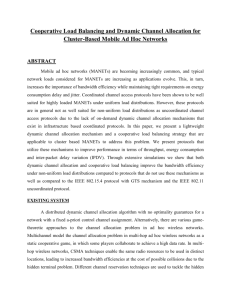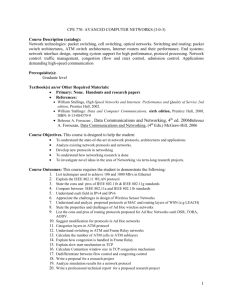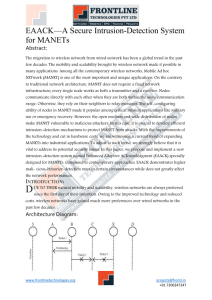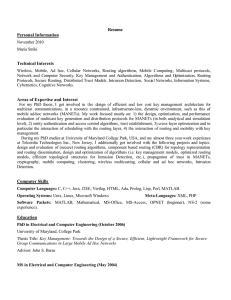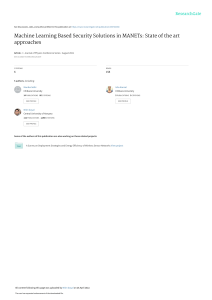Abstract - IEEE Projects in Chennai
advertisement
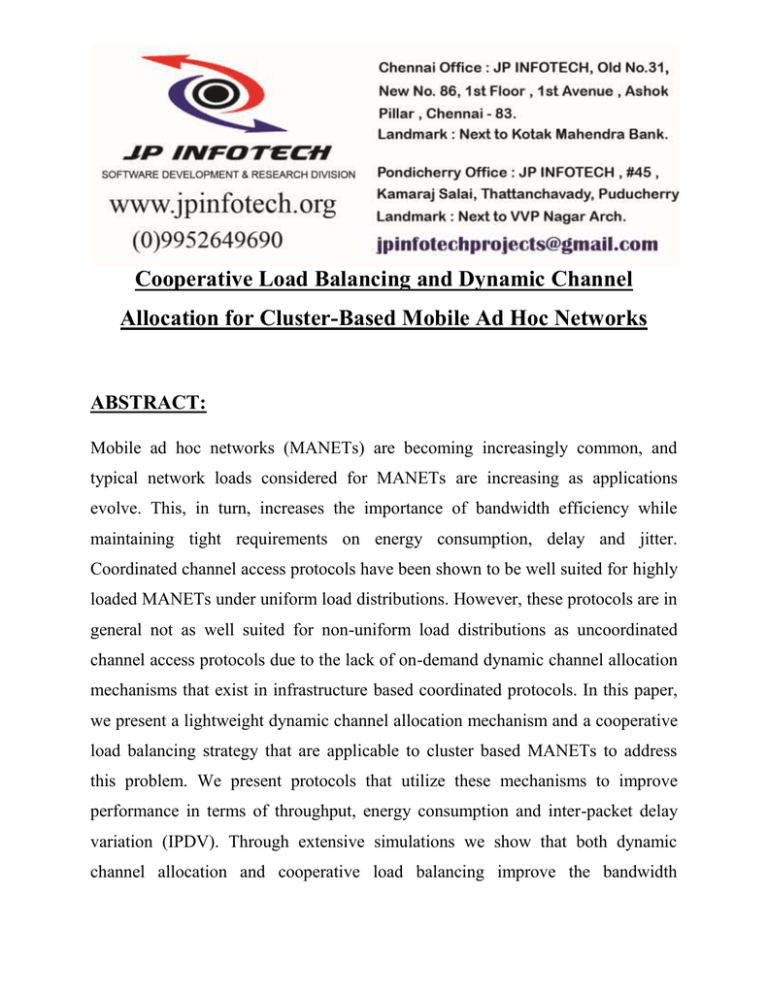
Cooperative Load Balancing and Dynamic Channel Allocation for Cluster-Based Mobile Ad Hoc Networks ABSTRACT: Mobile ad hoc networks (MANETs) are becoming increasingly common, and typical network loads considered for MANETs are increasing as applications evolve. This, in turn, increases the importance of bandwidth efficiency while maintaining tight requirements on energy consumption, delay and jitter. Coordinated channel access protocols have been shown to be well suited for highly loaded MANETs under uniform load distributions. However, these protocols are in general not as well suited for non-uniform load distributions as uncoordinated channel access protocols due to the lack of on-demand dynamic channel allocation mechanisms that exist in infrastructure based coordinated protocols. In this paper, we present a lightweight dynamic channel allocation mechanism and a cooperative load balancing strategy that are applicable to cluster based MANETs to address this problem. We present protocols that utilize these mechanisms to improve performance in terms of throughput, energy consumption and inter-packet delay variation (IPDV). Through extensive simulations we show that both dynamic channel allocation and cooperative load balancing improve the bandwidth efficiency under non-uniform load distributions compared to protocols that do not use these mechanisms as well as compared to the IEEE 802.15.4 protocol with GTS mechanism and the IEEE 802.11 uncoordinated protocol. EXISTING SYSTEM: • A distributed dynamic channel allocation algorithm with no optimality guarantees for a network with a fixed a-priori control channel assignment. • Alternatively, there are various game-theoretic approaches to the channel allocation problem in ad hoc wireless networks. • Multichannel model the channel allocation problem in multi-hop ad hoc wireless networks as a static cooperative game, in which some players collaborate to achieve a high data rate. • In multi-hop wireless networks, CSMA techniques enable the same radio resources to be used in distinct locations, leading to increased bandwidth efficiencies at the cost of possible collisions due to the hidden terminal problem. • Different channel reservation techniques are used to tackle the hidden terminal problem. Karn use an RTS/ CTS packet exchange mechanism before the transmission of the data packet. • 802.11 distributed coordination function (DCF) uses a similar mechanism. DISADVANTAGES OF EXISTING SYSTEM: • Existing approaches are not scalable • They not cover group communication PROPOSED SYSTEM: • In this project we propose two algorithms to cope with the non-uniform load distributions in MANETs: a light weight distributed dynamic channel allocation (DCA) algorithm based on spectrum sensing, and a cooperative load balancing algorithm in which nodes select their channel access providers based on the availability of the resources. • We apply these two algorithms for managing non-uniform load distribution in MANETs into an energy efficient real-time coordinated MAC protocol, named MH-TRACE. In MH-TRACE, the channel access is regulated by dynamically selected cluster heads (CHs). • MH-TRACE has been shown to have higher throughput and to be more energy efficient compared to CSMA type protocols. • Although MH-TRACE incorporates spatial reuse, it does not provide any channel borrowing or load balancing mechanisms and thus does not provide optimal support to non-uniform loads. ADVANTAGES OF PROPOSED SYSTEM: • Increase the throughput • Here we use scalable approach • Reduce energy consumption SYSTEM ARCHITECTURE: SYSTEM FLOW SYSTEM REQUIREMENTS: HARDWARE REQUIREMENTS: System : Pentium IV 2.4 GHz. Hard Disk : 40 GB. Floppy Drive : 1.44 Mb. Monitor : 15 VGA Colour. Mouse : Logitech. Ram : 512 Mb. SOFTWARE REQUIREMENTS: Operating system : Windows XP/7/LINUX. Implementation : NS2 NS2 Version : NS2.2.28 Front End : OTCL (Object Oriented Tool Command Language) Tool REFERENCE: : Cygwin (To simulate in Windows OS) Bora Karaoglu, Member, IEEE and Wendi Heinzelman, Senior Member, IEEE, “Cooperative Load Balancing and Dynamic Channel Allocation for Cluster-Based Mobile Ad Hoc Networks”, IEEE COMPUTING, VOL. 14, NO. 5, MAY 2015 TRANSACTIONS ON MOBILE
